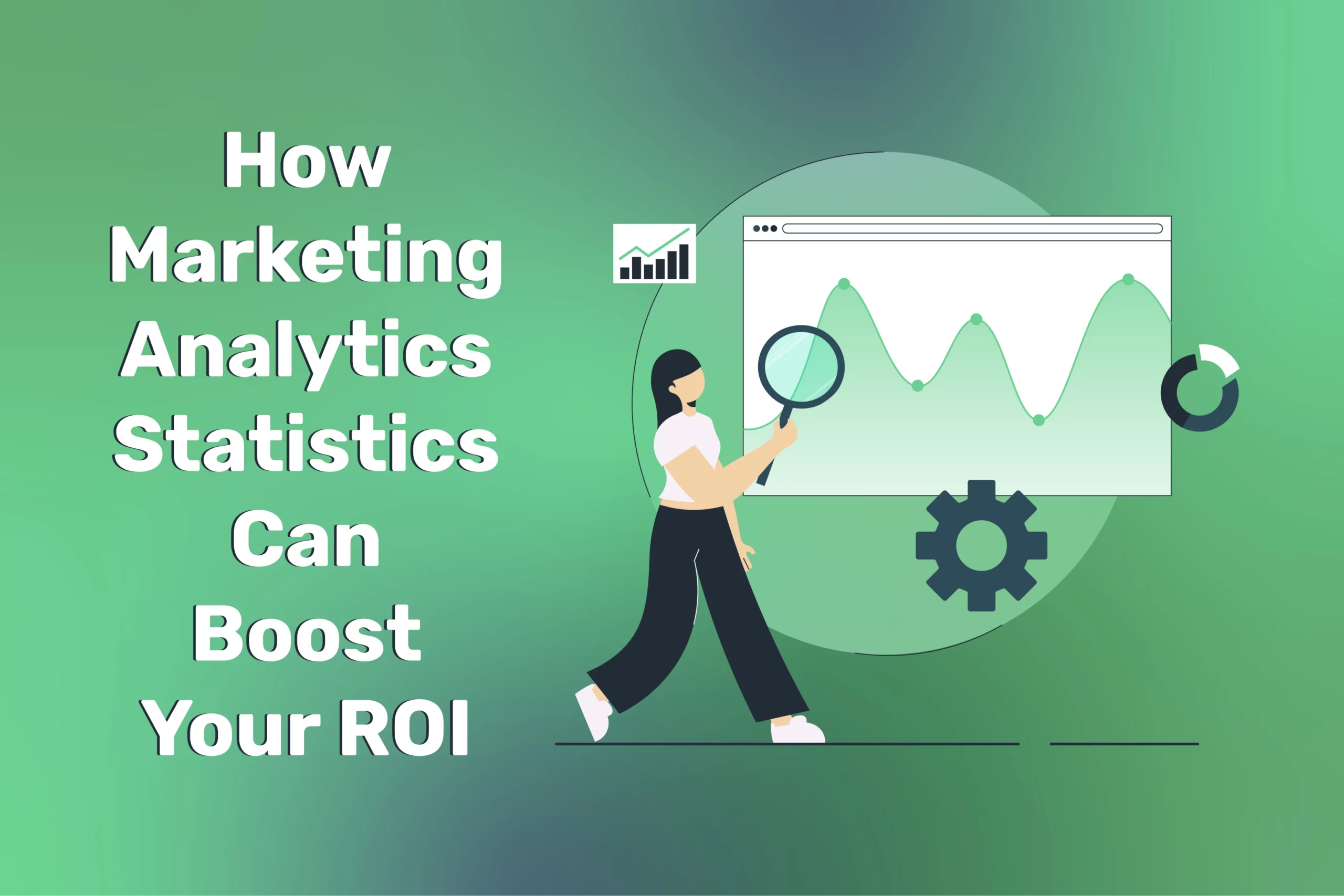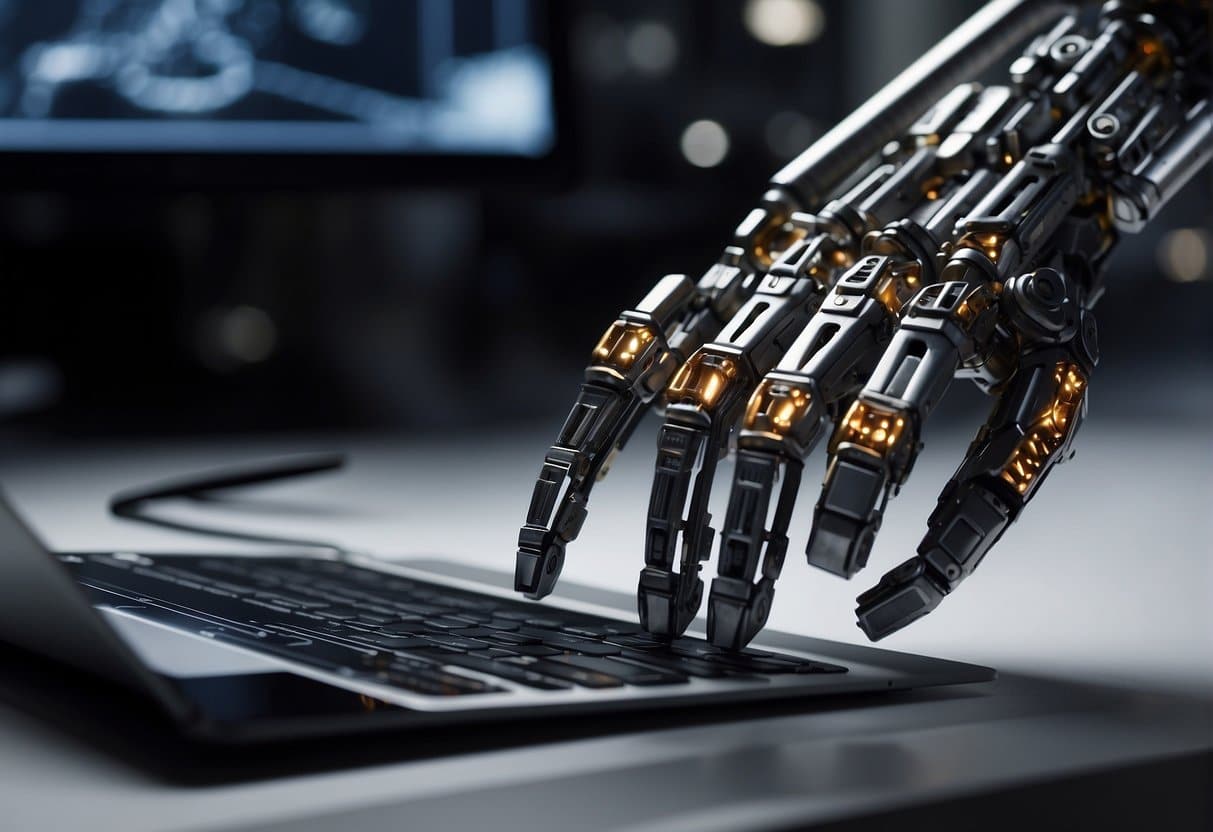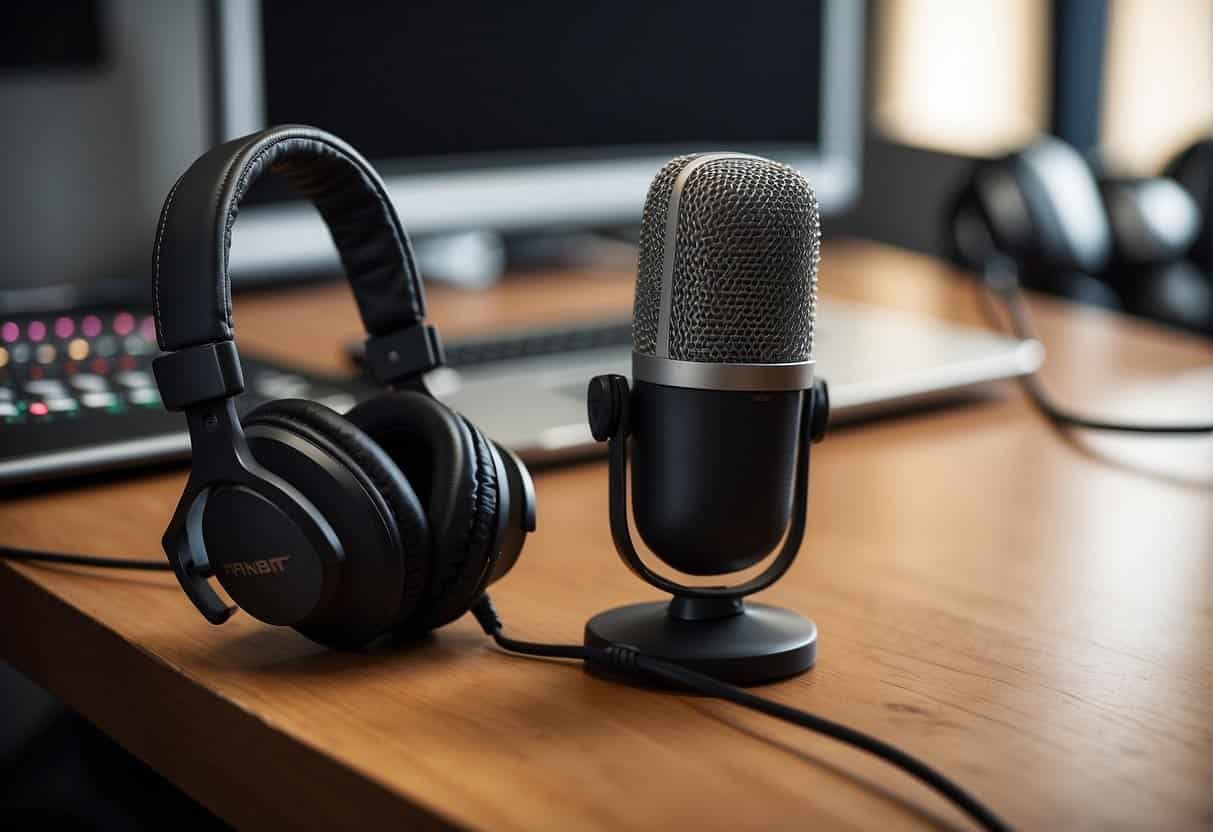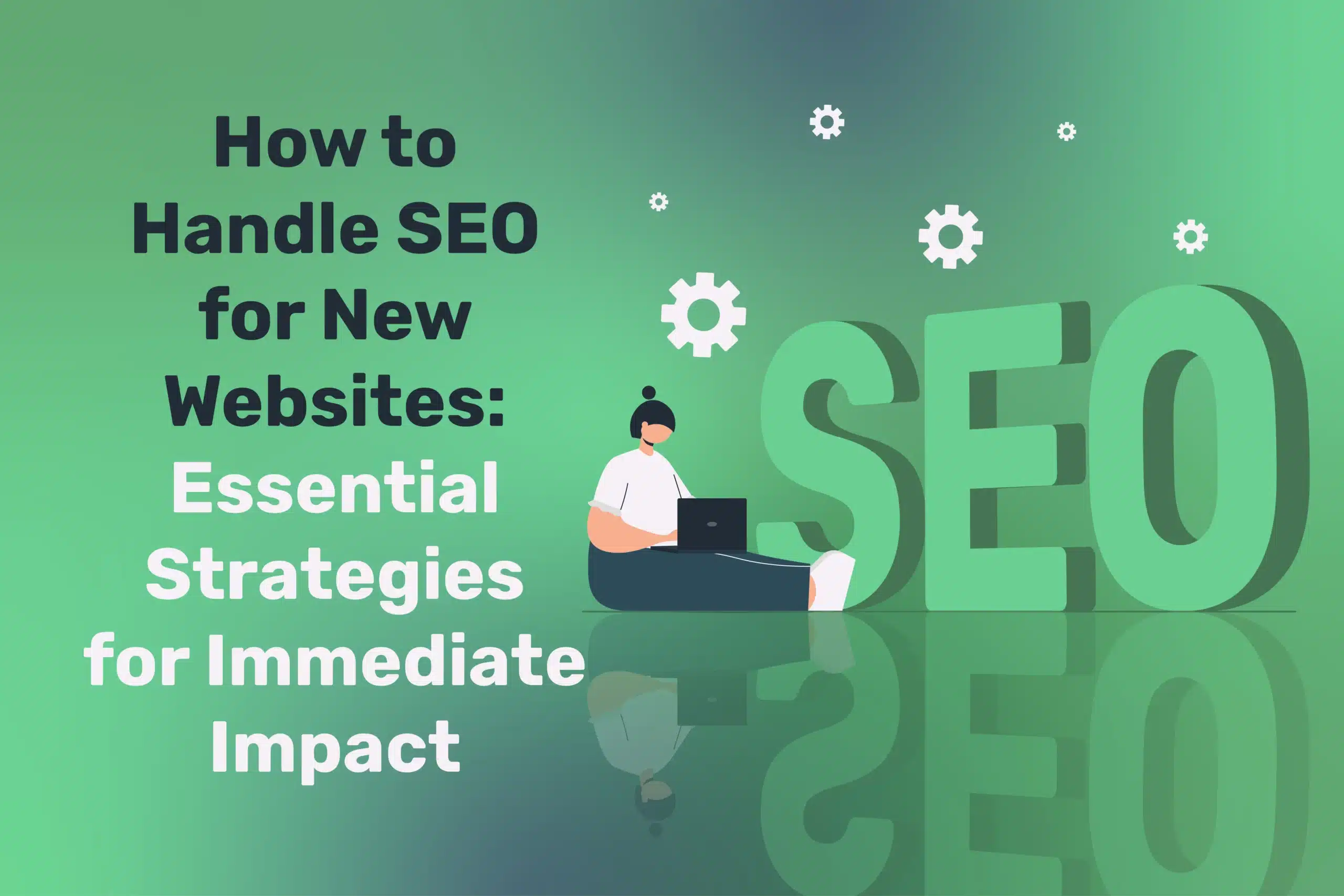
Music AI: Breaking Creative Barriers with Generative Tools
Table of Contents
Artificial intelligence has revolutionised numerous creative fields, and music production stands at the forefront of this transformation. Music AI—tools that compose melodies, suggest chord progressions, generate harmonies, or even produce complete tracks—has captured the imagination of the Music Industry. From amateur musicians seeking inspiration to professional producers looking to streamline workflows, these technologies are reshaping how music is conceived, created, and produced.
With innovative platforms like HookPad’s Aria, Lemonaide, AIVA, and BandLab SongStarter, composers can now forge powerful partnerships between human creativity and machine intelligence, pushing boundaries that were previously thought insurmountable. This comprehensive guide explores the fascinating world of music AI, examining leading platforms, providing advanced implementation strategies, and considering the profound creative and ethical implications of these technologies.
The Evolution of Music AI Technologies
Music AI has advanced from basic algorithms to sophisticated tools that generate, remix, and personalise music. With machine learning and neural networks, AI now analyses trends, predicts preferences, and enhances music production, reshaping creativity and industry workflows.
Historical Development
The journey of artificial intelligence in music creation has undergone remarkable transformation:
Early Foundations: The first AI music experiments emerged from rule-based systems and Markov chains, which generated relatively simple patterns based on probability. Pioneering systems like David Cope’s EMI (Experiments in Musical Intelligence) in the 1980s demonstrated early potential by analysing classical compositions to generate new works in similar styles.
Neural Network Revolution: The advent of deep learning and neural networks dramatically advanced AI music capabilities. Modern systems employ sophisticated architectures like recurrent neural networks (RNNs), long short-term memory networks (LSTMs), and transformers to understand and generate music with unprecedented complexity and nuance.
Contemporary Capabilities: Today’s music AI systems can analyse vast musical datasets, understand complex patterns across multiple genres, and generate compositions that exhibit coherent structure, harmonic progression, and even emotional expression.
Industry Transformation
The integration of AI into music creation has catalysed significant shifts across multiple sectors:
Professional Production: Composers and producers use AI to accelerate ideation, overcome creative blocks, and explore new sonic territories. These tools serve as collaborative partners rather than replacements, augmenting human creativity with computational efficiency.
Independent Artists: For independent musicians with limited resources, AI tools democratise production capabilities that once required expensive studio time and session musicians. This democratisation has led to greater creative freedom and market access.
Commercial Applications: From advertising jingles to game soundtracks, commercial music production has embraced AI for its ability to generate customisable, royalty-free music at scale—significantly reducing production time and costs.
Educational Impact: Music education has been transformed by AI tools that help students understand theory, practice composition, and receive immediate feedback on their creative exercises.
Industry Research: A comprehensive 2024 analysis revealed that approximately 30% of independent game developers now utilise AI-driven music tools for creating background scores and soundtracks. This trend highlights the growing adoption of AI as a cost-effective solution for iterative sound design in interactive media.
Comprehensive Analysis of Leading Music AI Platforms
Leading Music AI platforms offer powerful tools for composition, remixing, and personalised music generation. From AI-driven beat makers to adaptive sound design, these platforms leverage machine learning to enhance creativity and efficiency. A thorough analysis reveals their unique features, strengths, and how they cater to artists, producers, and businesses in the evolving music landscape.
Melody and Chord Generation Tools
HookPad’s Aria
Core Functionality: Specialises in intelligent chord progression and melodic line suggestions within an intuitive, theory-informed interface.
Key Strengths:
- Theory-based composition guidance rooted in popular music conventions
- Visual interface showing chord functions and relationships
- Real-time suggestions that respond to user inputs
- Seamless integration with HookTheory’s extensive pattern library
Ideal Applications:
- Songwriters seeking harmonic inspiration without coding requirements
- Music education and theory demonstration
- Quick ideation for verse-chorus structures in popular genres
Advanced Implementation Strategy: Maximise HookPad’s capabilities by combining its theory-driven suggestions with custom progressions. After generating initial ideas, export to MIDI for further development in your preferred DAW. For more distinctive outcomes, deliberately introduce modal interchanges or secondary dominants to the AI-suggested progressions, creating unique twists on familiar patterns.
Lemonaide
Core Functionality: Focuses on rapid generation of melodic phrases, hooks, and short musical motifs.
Key Strengths:
- Speed-oriented interface for quick idea generation
- Multiple variation options for each melodic seed
- Style-specific training delivering genre-appropriate suggestions
- Intuitive controls for non-technical users
Ideal Applications:
- Producers seeking catchy hooks or distinctive intro elements
- Composers experiencing melodic writer’s block
- Content creators needing consistent thematic elements across projects
Advanced Implementation Strategy: Generate at least 10-15 variations of a core idea, then analyse them for particularly compelling phrases or motifs. Create a composite melody by combining the strongest elements from multiple generations. For even more distinctive results, deliberately alter the rhythmic structure of AI-generated melodies while preserving pitch relationships, creating unique variations that maintain thematic coherence.
Complete Composition Platforms
AIVA (Artificial Intelligence Virtual Artist)
Core Functionality: Generates full-length compositions in multiple genres with particular strength in classical, cinematic, and ambient styles.
Key Strengths:
- Comprehensive compositional capabilities spanning multiple instruments
- Emotional tagging system for mood-specific generation
- Project-based composition with definable structural elements
- High-quality orchestral rendering suitable for professional applications
Ideal Applications:
- Independent filmmakers requiring orchestral scores
- Game developers needing adaptive, theme-based music
- Content creators seeking production-ready background music
- Composers looking for orchestral foundations to build upon
Advanced Implementation Strategy: Utilise AIVA’s project mode to develop thematic material across multiple sections, defining specific emotional arcs and intensity levels. For films or games, create variations on a central theme across different emotional registers, establishing a coherent musical identity that can adapt to narrative developments. After generating the foundational composition, selectively replace certain instrument sections with live recordings or premium sample libraries for enhanced realism in critical sections.
Soundraw
Core Functionality: AI-powered music creation platform focusing on complete, production-ready tracks with extensive customisation options.
Key Strengths:
- End-to-end music generation with high production quality
- Detailed control over tempo, instruments, and arrangement
- Genre-specific generation spanning contemporary styles
- Royalty-free licensing for commercial applications
Ideal Applications:
- Video content creators requiring customisable background music
- Podcasters seeking professional intro/outro music
- Small businesses needing bespoke marketing soundtracks
- Producers looking for fully-realised backing tracks
Advanced Implementation Strategy: Rather than accepting complete compositions, use Soundraw’s section-by-section generation to create custom arrangements. Generate multiple versions of verses, choruses, and bridges independently, then assemble them into a cohesive structure that serves your specific narrative or emotional requirements. For distinctive results, use Soundraw’s output as a foundational layer, then add custom instrumental or vocal elements that transform the AI-generated base into a truly unique composition.
Loop and Sample Generation Tools
BandLab SongStarter
Core Functionality: Creates musical building blocks including loops, progressions, and partial arrangements as starting points for further development.
Key Strengths:
- Seamless integration with BandLab’s cloud-based DAW
- Genre-diverse generation spanning contemporary styles
- Community-sharing features for collaborative development
- Free access with substantial capabilities
Ideal Applications:
- Bedroom producers seeking initial ideas or inspiration
- Bands looking for fresh approaches to arrangement
- Collaborative projects requiring shared musical foundations
- Electronic music producers seeking unique loop elements
Advanced Implementation Strategy: Use SongStarter to generate multiple loop sets across different instruments and styles, then combine elements from different generations to create unique hybrid arrangements. Export these foundations to a professional DAW for detailed editing, arrangement, and production. Consider deliberately juxtaposing AI-generated loops from contrasting genres to create unexpected musical fusions that retain coherence through shared rhythmic or harmonic elements.
Splice AI
Core Functionality: AI-powered sample and loop discovery within Splice’s extensive sound library, with generative capabilities for custom sound creation.
Key Strengths:
- Intelligent sample recommendation based on project context
- Generative capabilities for unique sound design
- Integration with major DAWs for seamless workflow
- Access to professionally produced source material
Ideal Applications:
- Electronic music producers seeking unique sound elements
- Hip-hop producers looking for distinctive samples
- Film composers requiring specific atmospheric sounds
- Sound designers needing efficient sound discovery
Advanced Implementation Strategy: Use Splice AI not just for discovery but as a creative partner in sound design. Generate variations on found samples using its processing tools, then layer these elements to create completely new composite sounds. Develop a systematic approach to cataloguing and tagging AI-generated sounds within your personal library, creating a growing resource of unique elements for future projects.
Strategic Benefits of Music AI Integration
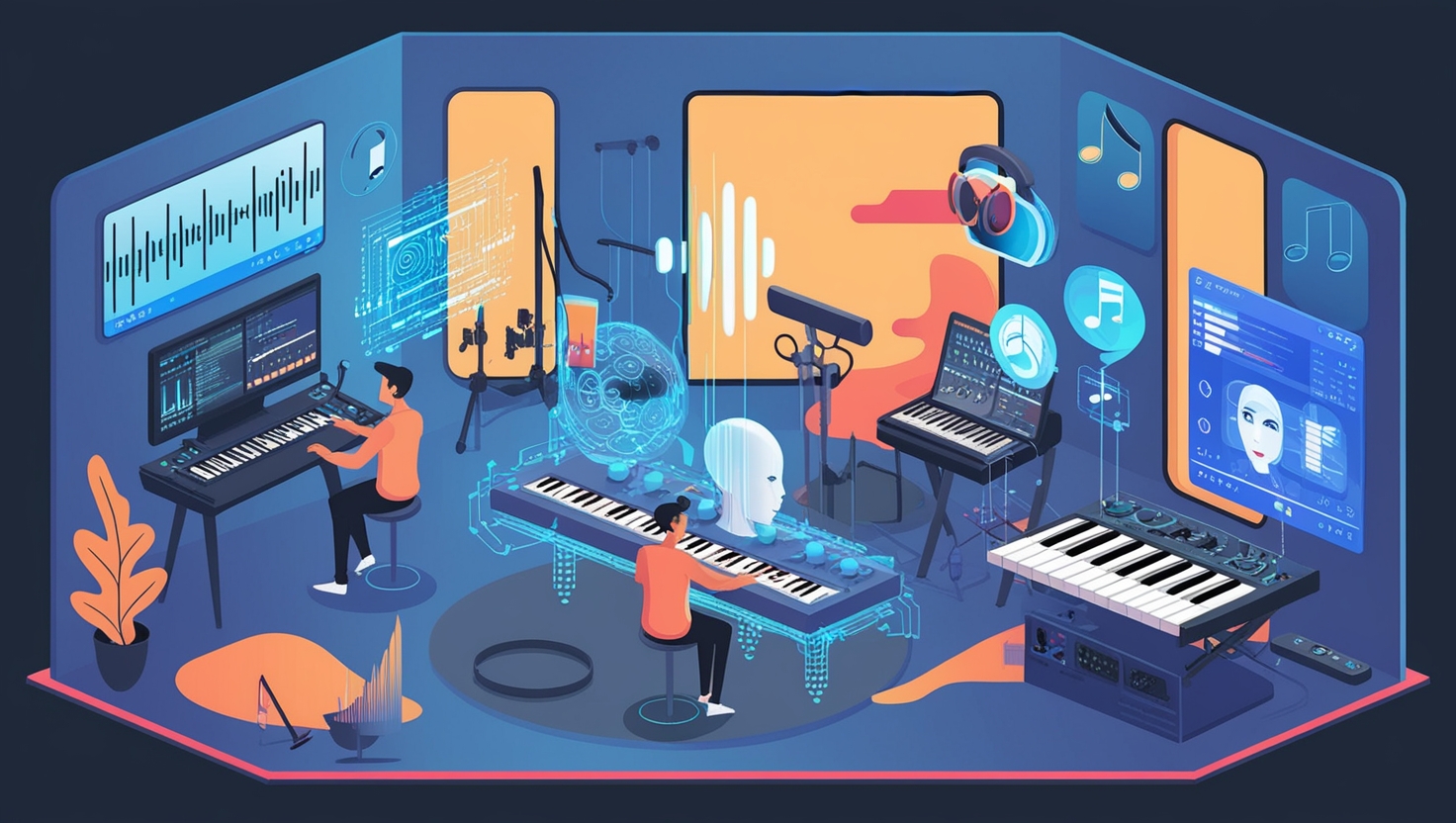
Integrating Music AI offers strategic advantages, from streamlining production to personalising listener experiences. AI-driven tools enhance creativity, automate tedious tasks, and provide data-driven insights for better audience engagement. Businesses and artists leveraging AI gain efficiency, scalability, and a competitive edge in an evolving digital music landscape.
Creative Efficiency and Workflow Enhancement
AI music tools fundamentally transform the creative process by accelerating ideation and production:
Rapid Prototyping: Musicians can generate and evaluate dozens of musical ideas in minutes rather than hours, allowing for broader exploration of creative possibilities.
Iterative Refinement: AI enables systematic exploration of variations on a theme, helping creators identify and develop the most promising elements.
Parallel Development: Composers can simultaneously develop multiple compositional approaches, comparing alternatives before committing to a specific direction.
Technical Assistance: AI can handle complex orchestration tasks or suggest appropriate chord voicings, allowing composers to focus on higher-level creative decisions.
Creative Block Resolution
For many musicians, creative blocks represent significant obstacles to productivity. AI offers several pathways through these challenges:
Novel Stimulus: AI-generated material provides fresh musical ideas that can trigger new creative directions when inspiration runs dry.
Systematic Variation: When a composition feels stale, AI can suggest alternative chord progressions, melodic variations, or arrangement options that preserve the essence while introducing novelty.
Genre Exploration: AI tools can help composers experiment with unfamiliar genres or fusion approaches, expanding their creative vocabulary.
Constraint Navigation: When specific project requirements create creative constraints, AI can efficiently generate options that satisfy technical parameters while maintaining artistic quality.
Production Economics
The financial implications of AI music tools extend beyond simple cost savings:
Resource Optimisation: Studios and production companies can allocate human creative talent to the most critical aspects of a project while using AI for foundational elements.
Scalable Production: Content platforms requiring large volumes of music can maintain quality while meeting demanding production schedules.
Democratised Creation: Independent creators gain access to capabilities that previously required substantial financial resources, levelling the competitive landscape.
Iterative Budgeting: Projects can allocate resources to multiple creative directions simultaneously, testing approaches before committing significant investment to a single path.
Educational Applications
Music AI serves as a powerful educational tool for developing musicians:
Theory Demonstration: AI can generate examples illustrating specific theoretical concepts, helping students understand abstract principles through concrete examples.
Stylistic Analysis: By generating music in the style of specific composers or eras, AI helps students recognise and internalise characteristic elements.
Immediate Feedback: Students can receive instant feedback on their compositions, accelerating the learning process.
Exploratory Learning: Novice composers can experiment with complex techniques like counterpoint or orchestration with guidance from AI systems.
Implementation Challenges and Strategic Solutions
Implementing Music AI comes with challenges such as data quality, creative control, and integration with existing workflows. Ensuring high-quality training data, maintaining human oversight, and adopting flexible AI solutions can help overcome these hurdles. A strategic approach balances automation with artistic intent, optimising AI’s benefits while preserving originality.
Creative Distinctiveness
Challenge: AI-generated music may exhibit predictable patterns or generic qualities that lack the distinctive character of human composition.
Strategic Solutions:
- Use AI outputs as foundation layers rather than finished products
- Deliberately introduce unexpected elements or deviations from conventional patterns
- Combine suggestions from multiple AI systems to create hybrid approaches
- Apply human judgement to identify and develop the most unique elements from AI suggestions
- Introduce cultural or personal influences that may not be represented in AI training data
Intellectual Property and Originality Considerations
Challenge: Questions surrounding the originality of AI-generated music and potential copyright implications present significant concerns.
Strategic Solutions:
- Research each platform’s training methodology and licensing terms thoroughly
- Select platforms offering clear commercial usage rights and indemnification
- Maintain documentation of your creative process showing substantial human contribution
- Consider platforms that offer “AI-labelled” certification guaranteeing originality
- Implement sufficient transformative elements to ensure distinctive final compositions
- Consult legal expertise for commercial projects with significant exposure
Emotional Authenticity
Challenge: AI systems may struggle to capture the emotional nuance and intentionality that defines compelling human music.
Strategic Solutions:
- Focus AI application on structural elements while preserving human control over expressive aspects
- Apply deliberate performance variations, dynamic shaping, and micro-timing adjustments to AI-generated material
- Use AI for harmonic and melodic foundations while applying human interpretation through performance
- Selectively replace critical emotional passages with human-composed alternatives
- Incorporate narrative or conceptual frameworks that guide emotional development beyond AI capabilities
Technical Integration
Challenge: Incorporating AI-generated elements into established production workflows can present technical hurdles.
Strategic Solutions:
- Establish standardised processes for exporting AI-generated material to your primary DAW
- Create template projects optimised for integrating AI-generated content
- Develop consistent naming conventions and organisational systems for AI-generated assets
- Invest in learning API or plugin integrations that connect AI tools directly to your workflow
- Build collaborative workflows that clearly delineate AI and human contributions
Creative Independence
Challenge: Over-reliance on AI tools may potentially limit development of personal compositional voice and technical skills.
Strategic Solutions:
- Establish clear creative objectives before engaging with AI tools
- Implement deliberate practice of traditional composition techniques alongside AI experimentation
- Analyse AI-generated material to understand underlying patterns and principles
- Use AI as a learning tool by studying its solutions to specific musical problems
- Gradually reduce dependence on AI for elements where you’ve developed proficiency
Advanced Implementation Frameworks for Professional Applications
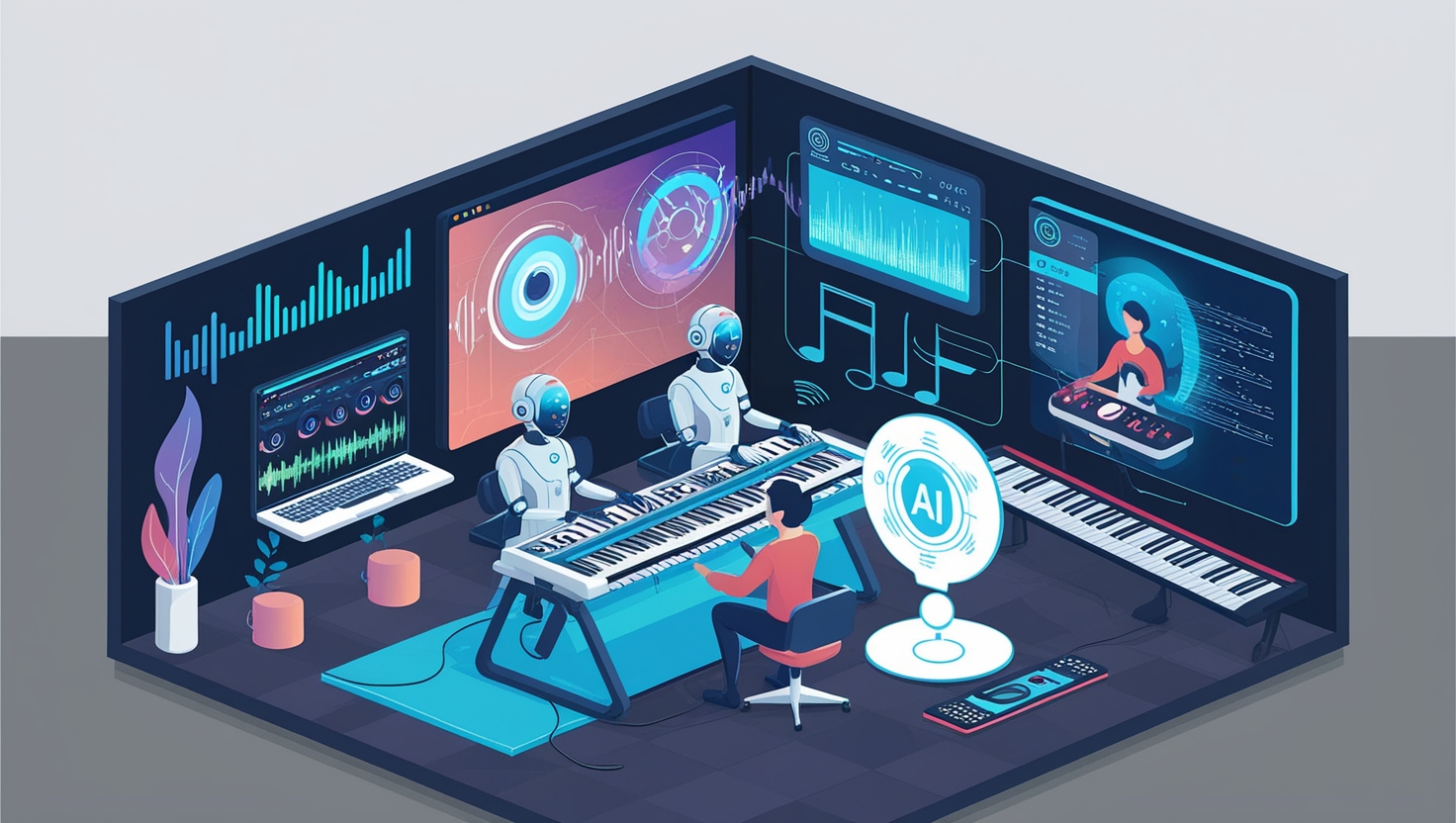
Advanced Music AI implementation requires a structured framework to optimise professional workflows. This includes selecting the right AI models, integrating them seamlessly into production tools, and ensuring creative alignment. By leveraging adaptive learning, real-time processing, and ethical AI considerations, professionals can maximise efficiency while maintaining artistic integrity.
Optimising AI Prompting Techniques
The specificity and structure of instructions provided to AI music systems significantly impact output quality:
Comprehensive Style Guidance:
- Reference specific genres, sub-genres, and era-specific characteristics
- Mention influential artists or compositions that exemplify desired elements
- Specify instrumentation, texture, and density preferences
- Include tempo, time signature, and rhythmic character details
Emotional and Contextual Framework:
- Describe intended emotional journey or narrative arc
- Specify functional context (background music, featured composition, etc.)
- Include audience considerations and intended response
- Reference visual or textual content the music will accompany
Technical Parameters:
- Define key, mode, and harmonic framework requirements
- Specify structural elements (intro length, verse-chorus relationship, etc.)
- Include transition requirements between sections
- Note any specific production characteristics (dry/wet, ambient/direct, etc.)
Multi-System Integration Approach
Sophisticated users often leverage multiple AI systems in coordinated workflows:
Layered Generation Strategy:
- Use specialised systems for different musical elements (harmony, melody, rhythm)
- Create foundation tracks with one system, then generate complementary elements with another
- Apply different AI tools to different sections based on their respective strengths
- Generate variants of core themes across multiple platforms, selecting optimal versions
Cross-Platform Refinement:
- Use feedback loops between systems to iteratively improve outputs
- Apply one AI’s analytical capabilities to evaluate another’s generative output
- Transform outputs between systems using appropriate conversion tools
- Create hybrid workflows combining AI strengths with human curation
Integrated Production Environment:
- Establish centralised project management systems for AI-assisted projects
- Develop consistent metadata approaches for tracking AI contributions
- Create template projects optimised for multi-system collaboration
- Implement version control systems that track both human and AI contributions
Human-AI Collaborative Methodologies
The most effective approaches position AI as a creative partner rather than a replacement:
Alternating Contribution Framework:
- Establish clear delineation of human and AI responsibilities
- Create structured workflows where AI and human contributions occur in defined sequence
- Implement deliberate evaluation points for human oversight
- Develop project-specific guidelines for when to accept, modify, or reject AI suggestions
Augmented Decision-Making:
- Use AI to generate multiple options for human selection
- Implement scoring or rating systems for evaluating AI outputs
- Develop personal criteria for assessing AI contributions
- Create documentation systems that record decision rationales
Skills-Based Allocation:
- Assign technical tasks to AI while reserving conceptual decisions for humans
- Leverage AI for time-consuming tasks requiring precision
- Maintain human ownership of defining characteristics and distinctive elements
- Create complementary relationships where each contributor works from strengths
Practical Implementation Case Studies
Real-world case studies showcase how Music AI enhances production, composition, and audience engagement. From independent artists using AI for mastering to major studios automating soundtrack generation, these examples highlight successful integration. Examining these cases provides insights into best practices, challenges overcome, and measurable business or creative outcomes.
Film Scoring Workflow
Project Context: Independent short film requiring orchestral score with limited budget.
Implementation Approach:
- Theme Development: Use AIVA to generate multiple thematic options based on film narrative and emotional arc
- Director Feedback: Present theme options for director selection and refinement
- Scene-Specific Adaptation: Generate variations of approved theme for different emotional contexts
- Integration: Import AI-generated orchestral stems into DAW
- Humanisation: Apply performance nuance and dynamic shaping
- Enhancement: Selectively replace critical solo lines with live recordings
- Production: Apply professional mixing and mastering techniques
Outcome: Professional-quality orchestral score delivered within budget constraints, combining AI efficiency with human expressiveness and director creative vision.
Electronic Music Production
Project Context: Electronic dance music producer seeking distinctive track foundations.
Implementation Approach:
- Beat Generation: Use Splice AI to discover and generate unique percussion elements
- Harmonic Foundation: Apply Lemonaide to create chord progression options
- Bass Design: Generate multiple bass line variations responding to selected progression
- Arrangement Structure: Use BandLab SongStarter to suggest structural frameworks
- Custom Sound Design: Apply human sound design expertise to AI-generated MIDI
- Performance Elements: Record live instrumental elements to complement AI foundation
- Production Refinement: Apply signature processing techniques and mixing approach
Outcome: Distinctive electronic track maintaining producer’s artistic identity while leveraging AI to expand creative possibilities and accelerate production timeline.
Commercial Jingle Development
Project Context: Advertising agency requiring multiple variations of brand theme.
Implementation Approach:
- Brief Analysis: Identify key brand values, target demographic, and communication objectives
- Thematic Generation: Use HookPad’s Aria to create chord progression options aligned with brand character
- Melodic Exploration: Generate multiple melodic options using Lemonaide
- Variation Development: Create genre-specific adaptations using Soundraw
- Client Presentation: Provide multiple high-quality options for client selection
- Refinement: Apply targeted revisions based on client feedback
- Finalisation: Produce broadcast-ready versions in various lengths and arrangements
Outcome: Efficient production of versatile brand theme with multiple variations, enabling comprehensive sonic branding within tight production timeline.
Establishing Authenticity in AI-Assisted Music Creation
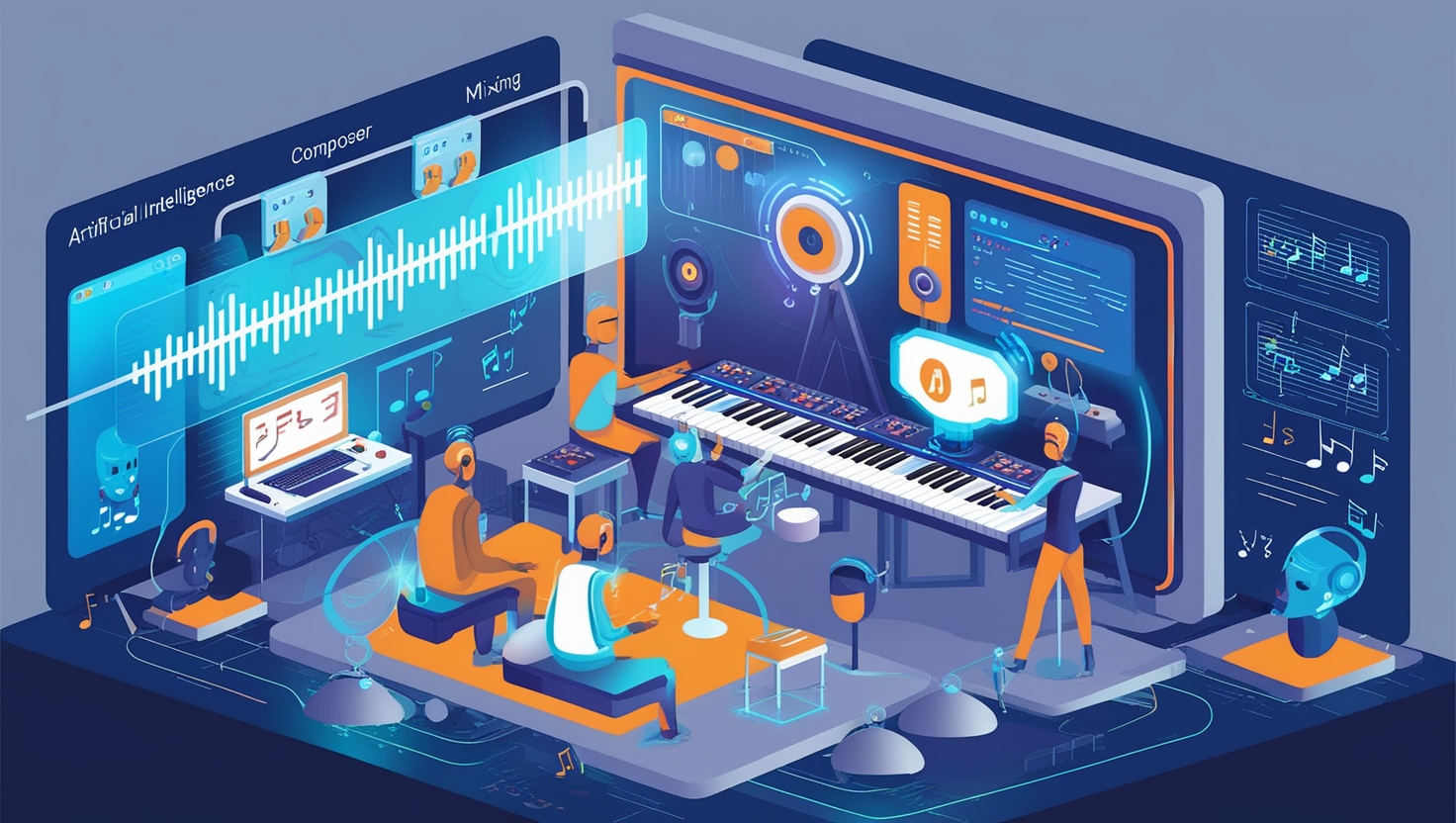
Maintaining authenticity in AI-assisted music creation requires a balance between automation and human creativity. Artists can achieve this by using AI as a collaborative tool rather than a replacement, infusing personal style, and refining AI-generated elements. Transparency about AI’s role in the process also fosters trust and credibility with audiences.
Transparency in Creative Process
Building trust with audiences through open communication about AI involvement:
Documentation Approaches:
- Creation of behind-the-scenes content showing human-AI collaboration
- Clear crediting of AI tools alongside human contributors
- Development of personal narratives explaining creative decisions
- Demonstration of the transformation from AI suggestion to final composition
- Create supplementary materials explaining creative process for interested audiences
- Develop appropriate language for credits and liner notes
- Consider platform-appropriate ways to acknowledge AI contribution without undermining artistic credibility
- Share insights about the specific value AI brought to the creative process
Demonstrating Expertise and Artistry
Establishing the value of human contribution within AI-assisted creation:
Expertise Demonstration:
- Highlight the critical judgements and selections made by human creators
- Explain the theory and principles guiding AI usage and evaluation
- Showcase technical enhancements applied to AI-generated foundations
- Demonstrate unique perspective and personal artistic vision
Authenticity Markers:
- Incorporate distinctive personal elements not replicable by AI
- Connect compositions to personal experiences or perspectives
- Apply signature techniques or approaches developed through experience
- Maintain consistent artistic voice across AI-assisted and traditional compositions
Building Credibility Through Quality and Consistency
Establishing trustworthiness through professional standards:
Quality Assurance:
- Apply rigorous evaluation criteria to all compositions regardless of creation method
- Maintain consistent production values across portfolio
- Seek feedback from trusted sources before release
- Implement systematic quality control processes
Long-term Relationship Building:
- Develop consistent artistic identity across projects
- Create coherent body of work demonstrating artistic growth
- Build direct connections with audience through authentic communication
- Establish reputation for integrity in creative approach
The Future Landscape of Music AI
The future of Music AI will be defined by more sophisticated creativity, real-time collaboration, and ethical considerations. As AI models improve, they will offer deeper personalisation, assist in live performances, and enhance music discovery. However, maintaining artistic authenticity and navigating copyright challenges will shape how the industry adapts.
Technological Horizons
Emerging capabilities that will shape the next generation of music AI:
Emotionally Responsive Systems:
- Real-time adaptation to listener emotional states through biometric feedback
- Dynamic composition responding to environmental factors or contextual cues
- Personalised emotional journeys tailored to individual listener preferences
- Integration with virtual and augmented reality experiences
Collaborative Ecosystems:
- Multi-user platforms enabling real-time co-creation between humans and AI
- Cloud-based environments supporting geographically distributed collaboration
- Intelligent agent systems mediating between multiple human contributors
- Community-driven training and refinement of shared AI resources
Multimodal Creation:
- Integrated systems generating synchronised music and visual content
- Cross-medium translation converting visual art to music and vice versa
- Narrative-driven composition responding to textual or spoken input
- Holistic experience design spanning multiple sensory domains
Creative and Cultural Implications
The broader impact of AI music technologies on creative expression and industry:
Evolving Creator Roles:
- Emergence of AI orchestration as a distinct creative discipline
- Shifting emphasis from technical execution to conceptual direction
- Development of new creative methodologies centred on human-AI collaboration
- Evolution of education and training to prepare for hybrid creation environments
- Changing economics of music production and distribution
- Evolving copyright and ownership frameworks for AI-assisted work
- New business models based on personalisation and adaptation
- Shifting barriers to entry and democratisation of production capabilities
Aesthetic Development:
- Exploration of new compositional approaches enabled by AI capabilities
- Evolution of genre boundaries and conventional structures
- Integration of computational aesthetics with human artistic tradition
- Development of new evaluation frameworks for hybrid human-AI creation
The Balanced Perspective: Human Artistry Enhanced by AI
Music AI represents one of the most fascinating intersections of technology and human creativity, offering powerful tools that expand possibilities while raising profound questions about the nature of artistic expression. The most successful applications of these technologies maintain a delicate balance—leveraging computational efficiency and pattern recognition while preserving the human elements that give music its emotional resonance and cultural significance.
For today’s musicians, producers, and composers, AI tools like HookPad’s Aria, Lemonaide, AIVA, and BandLab SongStarter offer unprecedented opportunities to accelerate creation, overcome limitations, and explore new territories. However, these tools achieve their greatest potential when viewed as collaborators rather than replacements—amplifying human creativity rather than substituting for it.
The future of music creation likely lies neither in pure human composition nor complete AI automation, but in the thoughtful integration of both approaches. By developing sophisticated collaborative methodologies, maintaining transparency about creative processes, and focusing AI on complementary strengths, musicians can harness these powerful technologies while preserving the essential human connection that gives music its enduring power.
As these technologies continue to evolve, so too will the creative practices surrounding them. The musicians who thrive in this changing landscape will be those who embrace AI’s capabilities while remaining firmly grounded in their artistic vision—using technology to enhance expression rather than replace it.
